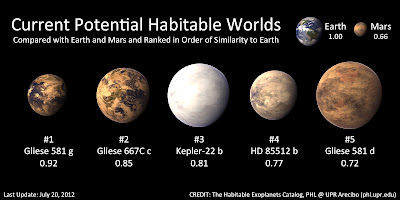 |
| Gliese, or GJ, 581 - a star 20 light years from here |
The Gliese 581 star system is roughly 20 light years away from Earth. If we could travel at the speed of light as a species, Gliese 581 is a place a human could visit in a single human lifetime. It is an M3 dwarf star, which is to say it is a Red Dwarf star. This means that its light is relatively faint compared to our Sun (which is a Yellow Dwarf star) and considerably smaller than our Sun, too. Scientists once felt that red dwarfs weren't places you would expect to find habitable worlds, but now - considering that red dwarfs make up maybe 70% of the Milky Way Galaxy - scientists are reconsidering. The Gliese 581 system is a good example of this change in attitude. Previous to the most recent news, Gliese 581 is suspected to contain up to 4 exoplanets (Vogt et al 2010).
Now a new paper out by Steven S. Vogt, R. Paul Butler, and Nader Haghighipour re-examines the previous HARPS data for the Gliese 581 system. They found that previous attempts to examine the system (Forveille et al 2011) excluded outlying data points. Re-examination of the numbers by Vogt's team confirmed the same 4 planers previously known as well as some additional worlds, including confirmation of the now famous Gliese 581g:
"The periodogram of the residuals to a 4-planet all-circular-model reveals significant peaks that suggest one or more additional planets in this system. We conclude that the present 240-point HARPS data set, when analyzed in its entirety, and modeled with fully self-consistent stable orbits, by and of itself does offer significant support for a fifth signal in the data with a period near 32 days."
 |
| Gliese 581 Star System with its Habitability Zone clearly marked |
The story of how this world has come to be known is not exactly a straightforward one. Its existence has been doubted since it was first announced. There has been a back-and-forth in the scientific community over whose models best predict how the Gliese 581 system functions - both with and without Gliese 581g. However, this newest paper presents the strongest case for its existence which, as stated above, puts this world square in the Habitable Zone of its star, Gliese 581. If Gliese 581g exists, it represents the best case for a habitable world outside of the earth, which is very exciting. Further more, if the data models hold, then the Gliese 581 system could be home to two potentially habitable worlds - while Gliese 581g sits square in the Habitable Zone, its neighbor Gliese 581d sits just inside the outer edge of that zone.
Keep an eye out for further confirmations of Gliese 581g in the future. The debate over whether this planet exists is not yet over...other scientists will examine the data again using different methods to see if Gliese 581g really exists (remember, we have to infer the existence of an exoplanet; seeing them directly is hard to do at this stage of the game). In the meantime check out the following links regarding this most recent Gliese 581g confirmation. Also, further below is an excellent chart listing what humanity thinks are the most habitable worlds, updated to include this most recent confirmation of Gliese 581g (provided by the Planetary habitability Laboratory).
You can read about the harrowing existence/non-existence of Gliese 581g here
Phys.org has an excellent write up on this newest confirmation here and is worth reading
io9 gives this story a fair dressing - read what they have to say here
 |
| The most habitable worlds we know so far. Click to embiggen. |
 |
| Illustration of the habitability zone of Gliese 581, as put together by the Planetary Habitability Laboratory. Notice it contains planets Gliese 581g and Gliese 581d. For further information from the PHL, please see this link. |

No comments:
Post a Comment